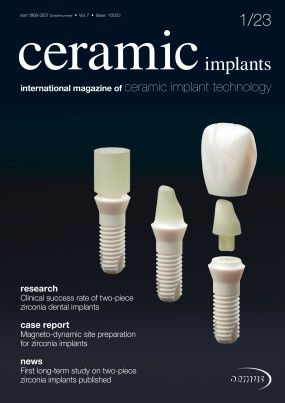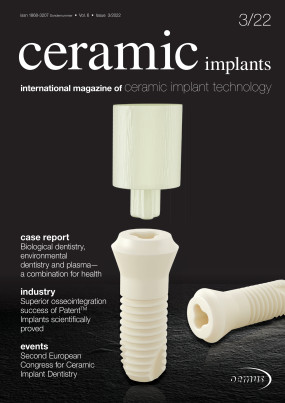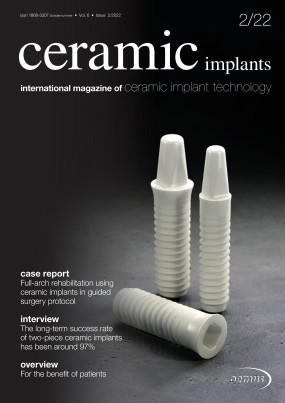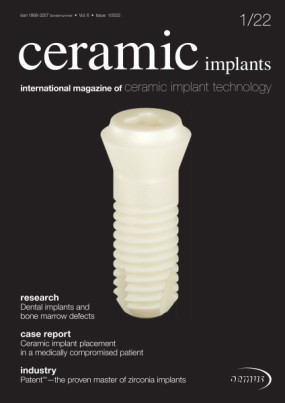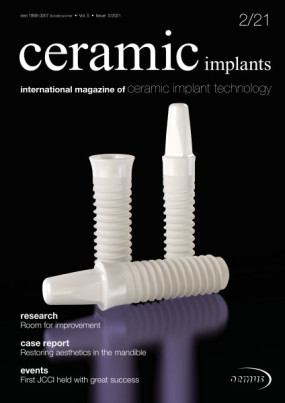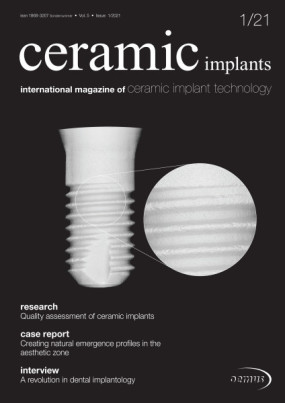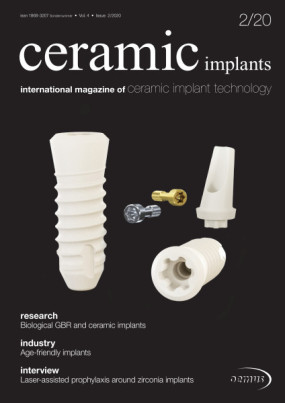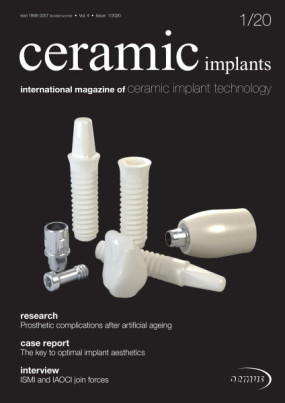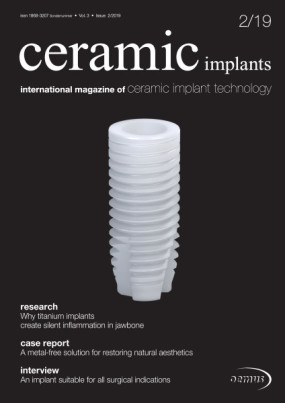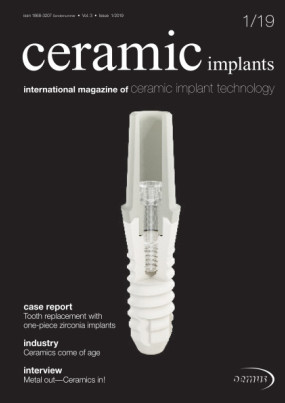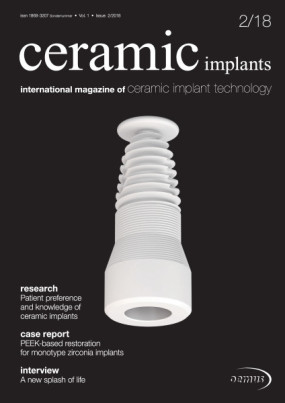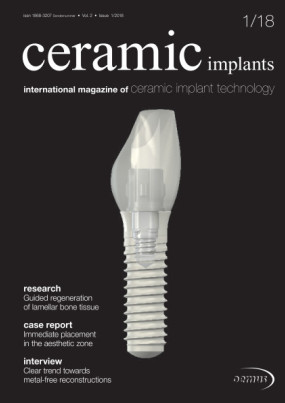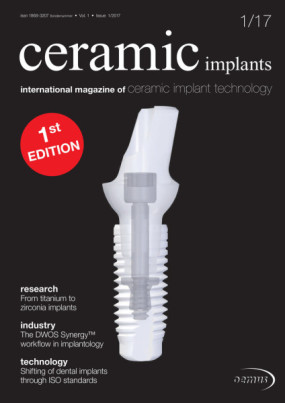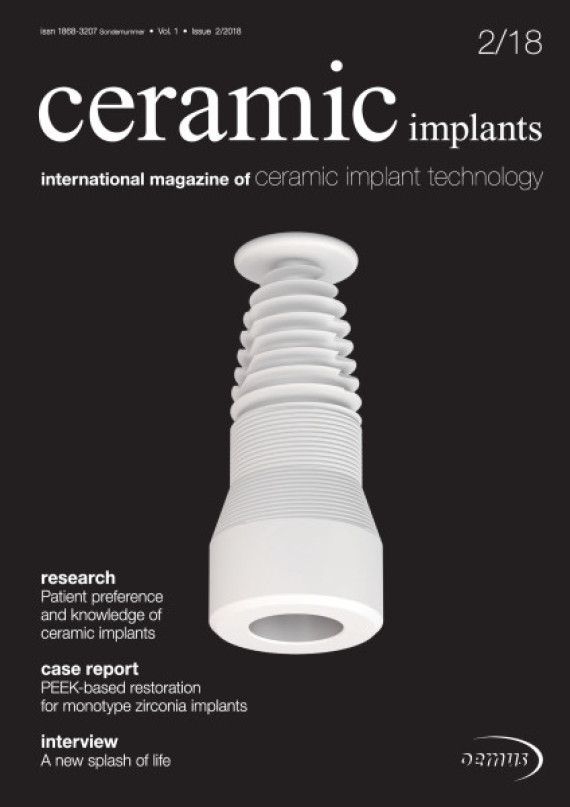Inhaltsverzeichnis
1
3
2018 has been a successful year for ceramic implantology in many ways. To begin with, the companies which are active in the field of ceramic implantology continue to prove the field’s potential for innovation. Today, there are a great number of modern two-piece systems available for dental patients to choose from, which come close to the prosthetic possibilities of titanium implants. Moreover, the micro-rough surfaces of the new systems have already proven themselves...
4
6
Patient preference and knowledge of ceramic implants
Dr Michael Gahlert, Prof. Heinz Kniha, Prof. Henriette Wölfler, Germany; Prof. Claude Jaquiéry & Dr Stefan Röhling, Switzerland
This investigation aimed to gather information from two dental patient populations on preferences regarding ceramic or metallic implants, and the factors that influence those preferences. Patients at dental centres in Switzerland and Germany received a 22-point questionnaire on knowledge of and preferences for implant materials...
10
Zirconium dioxide (ZrO 2 ) , or zirconia as it is more commonly known, was discovered in 1789 by the German chemist M. H. Klaproth. This material was introduced into dentistry only a few decades ago. Zirconia became an attractive alternative material in dentistry because of its high aesthetic potential and comparable strength to the conventionally used metals. In the field of implant dentistry, titanium has been the mainstay in implant manufacturing. However, zirconia became a viable option because it possesses superior properties, including a higher tensile strength, compressive strength and modulus of elasticity compared with either titanium alloy or commercially pure titanium (Table 1)...
16
PEEK-based restoration for monotype zirconia implants
Dr Saurabh Gupta, India & Dr Sammy Noumbissi, USA
For more than 40 years, the most commonly used dental implants have been commercially pure titanium and titanium alloy implants, and these are still considered to be the best and most reliable in the field of implant dentistry. 1
20
Patient demand for metal-free implant solutions is constantly increasing. While titanium implants are biocompatible and well tolerated, some studies have shown a presence of titanium oxide loads in the body after implantation. 1, 2 Inflammatory reactions of varying severity, depending on genetic susceptibility, have been detected in some patients. 3 In comparison, fewer cases of such reactions were observed for zirconium dioxide particles...
26
Bone formation is a complex biochemical process of endogenous regeneration that is influenced by a broad variety of factors. Scientific studies and everyday experience in dentistry practices confirm that the vitamin D3 level and the LDL level impact significantly on healthy bone formation. A patient with a vitamin D3 level below 70 ng/ml and an LDL level above 1.4 g/l will scarcely be able to form entirely healthy bones, no matter how much effort is invested in the procedure. A notable fact in this respect is that 85 per cent of all Germans return a D3 level below 30 ng/ml.1–4 This article addresses the issue of bone management for ceramic implants and outlines a protocol designed to stimulate and preserve healthy bones.
32
When Prince wrote his song “Gold” , of which the headline of this article quotes the refrain, he tried to explain the problem of having exaggerated expectations in a relationship. Presumably, he was not thinking about an ideal material for dental implants. Zirconium dioxide may have some advantages in comparison with titanium or ti tanium alloys. Better aesthetic appearance in case of sig nificant bone loss and low plaque affinity are benefits of this material...
34
Where are the evaluation criteria to determine the success of endodontic treatment? Why are there no additional tools to determine local painlessness versus a systemic toxicity focused approach? How can patients be convinced to get their root fillings replaced with immediate ceramic implants? In the following, scientific based arguments will be given from an author having 16 years of experience in ceramic implants. His scientific based publications are being released in international PubMed indexed medical journals and the research on this topic was published in the International Journal of General Medicine (“Stimulation of pro inflammatory cytokines by volatile sulfur compounds in endodontically treated teeth”, Lechner, von Baehr)...
36
Zirconia dental implants are increasing in popularity. More and more companies are offering zirconia implants as part of their portfolio. High aesthetics, increasing cases of titanium sensitivity along with clear health advantages are indicating zirconia as material of choice for dental implants. The main reasons for choosing zirconia include: ...
38
42
Numerous innovative restorative and aesthetic dental solutions, which are considered an industry standard today, have been brought to market by Nobel Biocare. Recently, the company expanded its product portfolio of dental implants and is now offering a complete metal- free, two-piece screw-connected option with Nobel - Pearl. The new ceramic implant system was first introduced at EuroPerio9 in Amsterdam, the Netherlands. In this interview with ceramic implants Prof. Stefan Holst, Vice President Global Research, Products & Marketing at Nobel Biocare (Fig. 1), discusses the new product line and what makes it stand out from other systems available on the market...
44
Today, there is an increasing focus on ceramic implants. In future, there will barely be any dental implant suppliers who are able to do without metal-free alternatives. Both the material and the designs have become quite sophisticated and there is plenty of practical experience with respect to tens of thousands already placed implants. Being praised by only a few enthusiasts in the past, the fourth annual meeting of the International Society of Metal Free Implantology (ISMI) has shown that ceramic implants have already changed the market. The event was held in the Empire Riverside Hotel in Hamburg, Germany, on the penultimate weekend of July, inviting ...
46
Ceramic implant dentistry is currently one of the fastest growing, most innovative, but often controversial discussed areas in dentistry. Intensive research and development, especially in the areas of material properties, surface design and restorative care, have led to ceramic implants of zirconium oxide being a credible factor in dental implantology in addition to titanium implants. Scientific data are already available, but need to be evaluated correctly...






